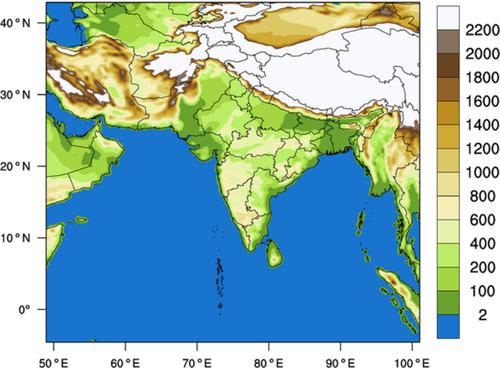当前位置:
X-MOL 学术
›
Meteorol. Appl.
›
论文详情
Our official English website, www.x-mol.net, welcomes your feedback! (Note: you will need to create a separate account there.)
Performance of hydrostatic and non‐hydrostatic dynamical cores in RegCM4.6 for Indian summer monsoon simulation
Meteorological Applications ( IF 2.7 ) Pub Date : 2020-05-28 , DOI: 10.1002/met.1915 R. K. S. Maurya 1 , M. R. Mohanty 1 , P. Sinha 1 , U. C. Mohanty 1
Meteorological Applications ( IF 2.7 ) Pub Date : 2020-05-28 , DOI: 10.1002/met.1915 R. K. S. Maurya 1 , M. R. Mohanty 1 , P. Sinha 1 , U. C. Mohanty 1
Affiliation

|
The efficacy of regional climate model RegCM4.6 using hydrostatic core resolutions at 36km (HY36) and 12km (HY12) and a non‐hydrostatic core resolution at 12km (NH12) is investigated by simulating the normal, excess and deficit monsoon seasons. The ERA‐Interim reanalysis data are used to drive the model and the India Meteorological Department (IMD) and modern‐era retrospective analysis for research and applications (MERRA) rainfall data are used for precipitation verification. The heavy rainfall regions are well simulated in the high‐ compared with the coarse‐resolution simulations, with the maximum in the NH12. The non‐hydrostatic dynamics amalgamate the vertical acceleration with the orographic uplifting that causes more precipitation over hilly regions than that of the hydrostatic core. On the other hand, the lesser precipitation over northwest India is better portrayed in the HY12 than in the other two. Over central India, the HY36 performs better followed by the NH12; and the contrasting precipitation features are also well depicted in the HY36 and NH12. This is probably because of the better representation of large‐scale monsoon features, such as a monsoon trough in the HY36 and local‐scale convective activities in the NH12. Daily rainfall analysis also shows that the high‐resolution model is capable of capturing the active and break phases during the El Niño and La Niña seasons. The non‐hydrostatic model possesses good correlation co‐efficients >0.5 over the hydrostatic model with co‐efficients of 0.35. The analysis of upper air circulations and the derived parameters, including statistical tests, confirm that the RegCM4.6 with non‐hydrostatics is useful for orographic regions, hydrostatic at a coarse resolution and non‐hydrostatic at a finer resolution and could be suitable for plain regions.
中文翻译:

RegCM4.6中的静水和非静水动力岩心在印度夏季风模拟中的性能
通过模拟正常,过量和不足季风季节,研究了使用36 km(HY36)和12km(HY12)静水核心分辨率和12km(NH12)静水核心分辨率的区域气候模型RegCM4.6的有效性。ERA-中期再分析数据用于驱动该模型,印度气象部门(IMD)和现代研究和应用回顾性分析(MERRA)降雨数据用于降水量验证。与粗分辨率模拟相比,高降雨地区得到了很好的模拟,而NH12则达到了最大值。非静水动力学随着地形的隆起合并垂直加速度,这导致丘陵地区的降水比静水岩心更多。另一方面,与其他两个州相比,HY12在印度西北部的降水较少。在印度中部,HY36表现更好,其次是NH12;在HY36和NH12中也很好地描绘了相反的降水特征。这可能是因为更好地表示了大型季风特征,例如HY36的季风槽和NH12的局部规模对流活动。每日降雨分析还表明,高分辨率模型能够捕获厄尔尼诺和拉尼娜季节的活跃期和中断期。非静水模型与静水模型具有0.35的良好相关系数,大于0.5。对高空循环和衍生参数的分析(包括统计测试)证实了RegCM4。
更新日期:2020-05-28
中文翻译:

RegCM4.6中的静水和非静水动力岩心在印度夏季风模拟中的性能
通过模拟正常,过量和不足季风季节,研究了使用36 km(HY36)和12km(HY12)静水核心分辨率和12km(NH12)静水核心分辨率的区域气候模型RegCM4.6的有效性。ERA-中期再分析数据用于驱动该模型,印度气象部门(IMD)和现代研究和应用回顾性分析(MERRA)降雨数据用于降水量验证。与粗分辨率模拟相比,高降雨地区得到了很好的模拟,而NH12则达到了最大值。非静水动力学随着地形的隆起合并垂直加速度,这导致丘陵地区的降水比静水岩心更多。另一方面,与其他两个州相比,HY12在印度西北部的降水较少。在印度中部,HY36表现更好,其次是NH12;在HY36和NH12中也很好地描绘了相反的降水特征。这可能是因为更好地表示了大型季风特征,例如HY36的季风槽和NH12的局部规模对流活动。每日降雨分析还表明,高分辨率模型能够捕获厄尔尼诺和拉尼娜季节的活跃期和中断期。非静水模型与静水模型具有0.35的良好相关系数,大于0.5。对高空循环和衍生参数的分析(包括统计测试)证实了RegCM4。

























 京公网安备 11010802027423号
京公网安备 11010802027423号